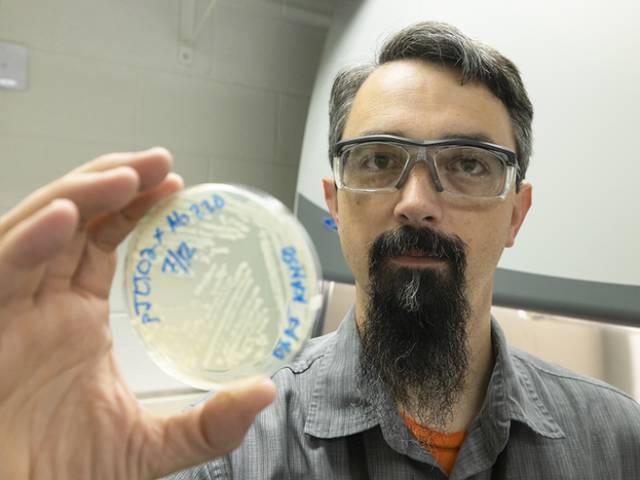
ORNL’s Adam Guss began adapting the SAGE gene editing tool to modify microbes in graduate school. Today, SAGE is rapidly accelerating the design of custom microbes for a variety of applications. Credit: Carlos Jones/ORNL, U.S. Dept. of Energy
Genetic engineering of microorganisms, such as bacteria and fungi, has a wide range of current and potential applications, including in biofuel synthesis, plastic recycling and the development and manufacturing of new medicines. However, while efficient, high-throughput gene-editing methods have been developed for model organisms, such as E. coli, application of these methods to a broader array of diverse bacteria has been limited. Researchers at Oak Ridge National Laboratory (ORNL), Pacific Northwest National Laboratory (PNNL) and the University of California, Berkeley have now developed a novel gene-editing tool that could expand the range of microorganisms that can be efficiently engineered, and greatly accelerate the design of custom microbes for a variety of applications.
The new tool, called Serine recombinase-Assisted Genome Engineering (SAGE), can integrate up to 10 different DNA constructs into diverse bacterial genomes, in a process that takes as little as four 8-hour workdays. The use of serine recombinases expressed from nonreplicating plasmids, rather than tyrosine recombinases and the replicating plasmids commonly used in other methods, expands the range of hosts that can be engineered using the SAGE system. Serine recombinases do not require specific host proteins to function, and the use of a nonreplicating plasmid avoids issues such as variations in plasmid copy number between species, or the need to use methods such as antibiotic selection to maintain genetic stability. The broad applicability of SAGE removes the need to undertake the lengthy process of closely tailoring gene integration methods to a specific host species.
The researchers tested SAGE on five bacteria representing a variety of taxonomic groups and potential applications. This included Psuedomonas fluorescens, a model plant growth-promoting rhizobacteria; Rhodopseudomonas palustris, which has potential applications in hydrogen production, biodegradation and biofuel production; and an undomesticated Pseudomonas bacteria isolated from soil surrounding a drought-tolerant sorghum plant. SAGE was able to successfully integrate a 10-sequence cassette into the diverse species with comparable or greater efficiency compared with conventional methods using replicating plasmids. Additionally, the researchers showed, using flow cytometry to measure fluorescent reporter expression, that the inserted genes remained stable over 20 generations without the use of maintenance methods like antibiotic selection. The use of nonreplicating plasmids means SAGE could potentially be used to engineer microbes in environments where selection methods are impractical, such as in large industrial reactors or in a soil environment. This research was published in Science Advances.
“SAGE works in virtually all microorganisms, revolutionizing what we’re able to do with microbes,” said co-author Adam Guss, of ORNL.